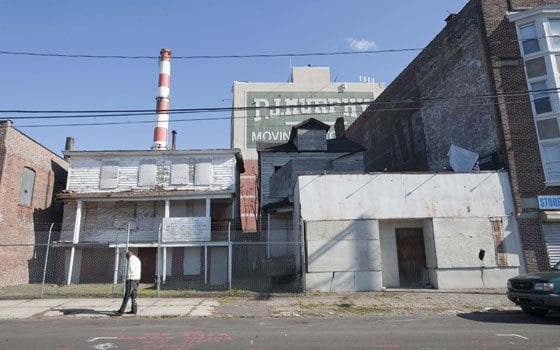
BRIDGEPORT, Conn. — The oldest remaining houses built by free blacks in Connecticut, considered irreplaceable by national historians, sit boarded and weather-beaten on a dispirited stretch of Bridgeport’s Main Street.
The homes, erected in 1848 just as Connecticut outlawed slavery in its borders, are the last remnants of the city’s once-thriving “Little Liberia” neighborhood of free black residents.
Now, the tale of the two wood-frame houses and the entrepreneurial Freeman sisters who owned them is showcasing the significance of such antebellum communities — but just as preservation money for the houses is especially scarce.
A deal with the city of Bridgeport after lengthy negotiations recently saved them from foreclosure for back taxes. However, supporters’ joy at overcoming that hurdle is tempered by worry that the bad economy may hamper donations for the preservation work before it even starts.
Cost estimates for their renovation haven’t been determined, but are expected to easily surpass $1 million.
The adjacent houses, built by sisters Mary and Eliza Freeman, were around the corner from the home of their brother, Joel, whose harborside property is suspected by historians to have been an Underground Railroad stop.
They’ve survived countless tenants, urban renewal projects that leveled buildings around them, at least one fire and 160 years of New England winters. Long overlooked in a city where blight is a constant challenge, the houses survived by chance rather than design _ largely because no one ever got around to tearing them down.
“It’s like there’s some force up in the sky that protected them,” said Charles Brilvich, a former Bridgeport city historian who has researched Little Liberia extensively.
Added Maisa Tisdale, head of the volunteer Friends of the Freeman Houses group: “We’re going with the guardian angel theory.”
Little Liberia, which was settled around 1820, wasn’t alone in its status as a booming antebellum community of free black residents in the north.
They gathered in similar neighborhoods in many cities with growing job markets and easy water access, notably the northern slope of Boston’s Beacon Hill, Sandy Ground on New York’s Staten Island and Hard-Scrabble in Providence, R.I.
Some residents were born free in the north, emancipated by northern owners or had escaped from southern slavery. Others came from the West Indies, Cape Verde Islands and other regions for seafaring jobs.
“Places like Little Liberia have a huge place in history because even though the residents were free, they weren’t living in what you would consider true freedom,” Tisdale said. “They were separated and segregated from the white residents, and that meant they made their own vibrant communities.”
Little Liberia, whose heyday ran from the 1820s through the end of the 19th century, was so prosperous that it boasted Bridgeport’s first public library. It also had scores of businesses, fraternal organizations, churches, a fancy hotel — all built and patronized by free blacks.
The Freeman houses housed sisters Mary and Eliza Freeman, single women whose business and real estate activities in Bridgeport and New York City left them comfortably well-off.
Mary bought out the interest of other heirs in Eliza’s properties when her older sister died. Mary Freeman went on to build an estate estimated at $30,000 to $50,000 when she died in 1883 — or about $665,200 to $1.1 million in 2008 dollars, accounting for inflation.
The scores of other buildings that comprised Little Liberia are long gone.
In their place stand newer structures, warehouses, empty lots and mom-and-pop businesses, all in the shadow of the new Arena at Harbor Yard complex that cuts off that southern part of Main Street from the heart of the city.
And in the midst of it: the boarded Freeman houses, which have been vacant since 1981 and which the National Trust for Historic Preservation calls rare and irreplaceable evidence of African-American life before Emancipation.
The group Action for Bridgeport Community Development and the city of Bridgeport recently agreed to a deal in which the city gets title to the structures in return for forgiving about $170,000 in back taxes, incurred during a lengthy debate about whether they were tax-exempt.
The ABCD group also gets a building to use for a daycare center.
The city plans to sell the Freeman houses for $1,000 to an as-yet undetermined nonprofit historical society for renovation — possibly the nonprofit that the Friends of the Freeman Houses group is setting up while launching a fundraising campaign.
They hope the houses will eventually become a museum, tourism center or other sort of attraction to educate people about the Freeman sisters, Little Liberia and similar antebellum villages of free blacks.
“Free black residents couldn’t vote and in many areas in the U.S. [they] couldn’t own property, yet here they were flourishing,” Bridgeport Mayor Bill Finch said. “I love Bridgeport’s history, but this is even more important than the history of our own city. It’s the history of this community and others like it that survived and prospered despite everything going against them.”
(Associated Press)






